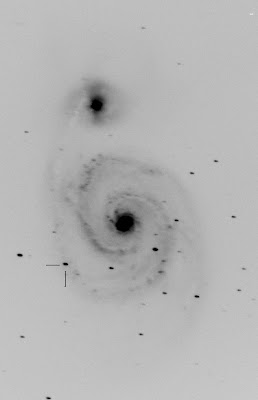You can tell by reading my blog that I am an avid visual observer. I have resisted the urge to enter into the "dark world" of imaging. I am not really sure why I have resisted, perhaps the initial cost of the equipment, or perhaps the time spent observing would be spent with a lot fewer objects. For what ever the reason, I have not entered the imaging world many of my peers, well, until now, sort of....
In recent years, several for-hire robotic telescopes have been popping up on the Web. These are scopes with sophisticated automation, usually residing in a dark site, that amateurs like myself can utilize for imaging. Some of these sites are supported by membership fees, or time rental. Well, I was not really interested in spending part of my hobby budget on something that was not as tangible as a new eyepiece or software. However, I found a site that was a free service. The University of Bradford has a robotic scope in the Canary Islands which they have set up as a public outreach program. Anyone can submit a job request to image an object. The user has the ability to select exposure times, dark frames, and different filters. The jobs go into a que and are run on some type of priority basis. I have had jobs completed in as little as 48 hours.
I recently submitted a couple of requests . This first one is of M51 that was taken on July 24th. This is one of the Arp Galaxies which is interacting with a neighbor. You can clearly see the spiral arm that wraps from the larger to the smaller galaxy. In the arm at the place indicated by the cross is a super nova. This is SN2011dh discovered earlier this year.
This was a 2 minute exposure done with a dark frame applied and no filters. It was amazingly simple and provided such a nice image. It is surprising to see how much detail is present in the spiral arms. Adjusting the contrast of the image will bring out different aspects of the galaxy.
The image below is NGC 4631, or the Whale Galaxy. This was another 2 minute exposure taken on July 24th. Above the galaxy you can see the companion, NGC 4627. Again, there is surprising detail in the structure of the galaxy. There are nodules along the galactic plain indicating possible concentrations of stars or star forming regions.
So, am I about to go out and purchase a bunch of imaging equipment? Probably not. I see this as more of a cloudy night activity where I can check out interesting subjects, or perhaps perform my own supernova search. For those of you who are more the armchair observer, then this site was tailor-made for you. Log on and give it a try, or just look at some of their images in their gallery.
Clear skies;
rw

